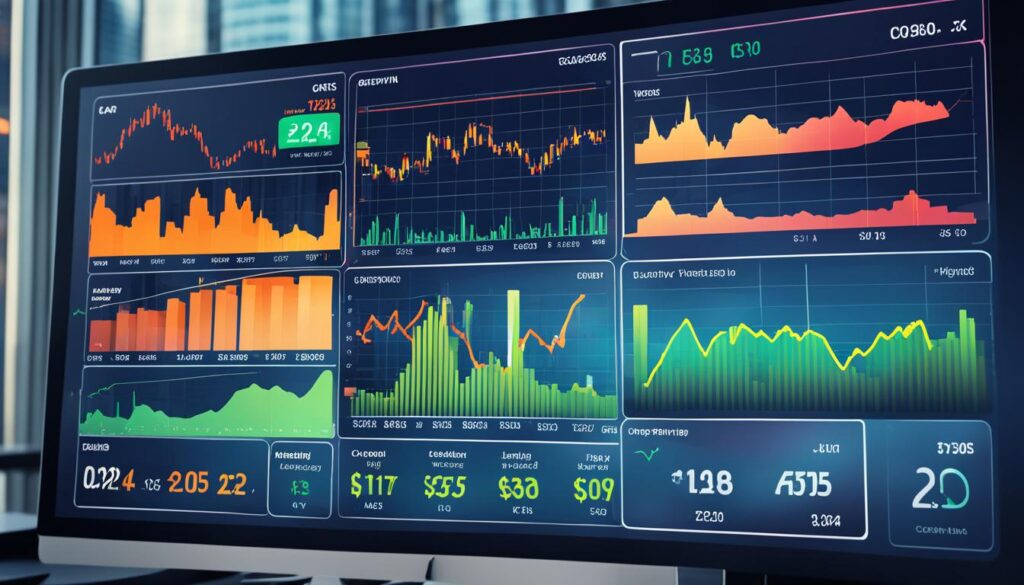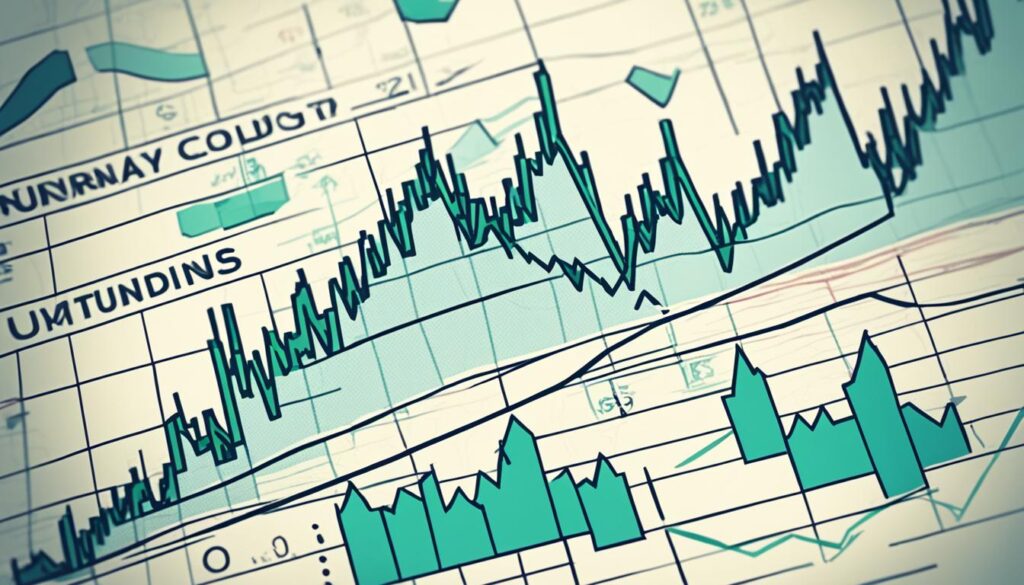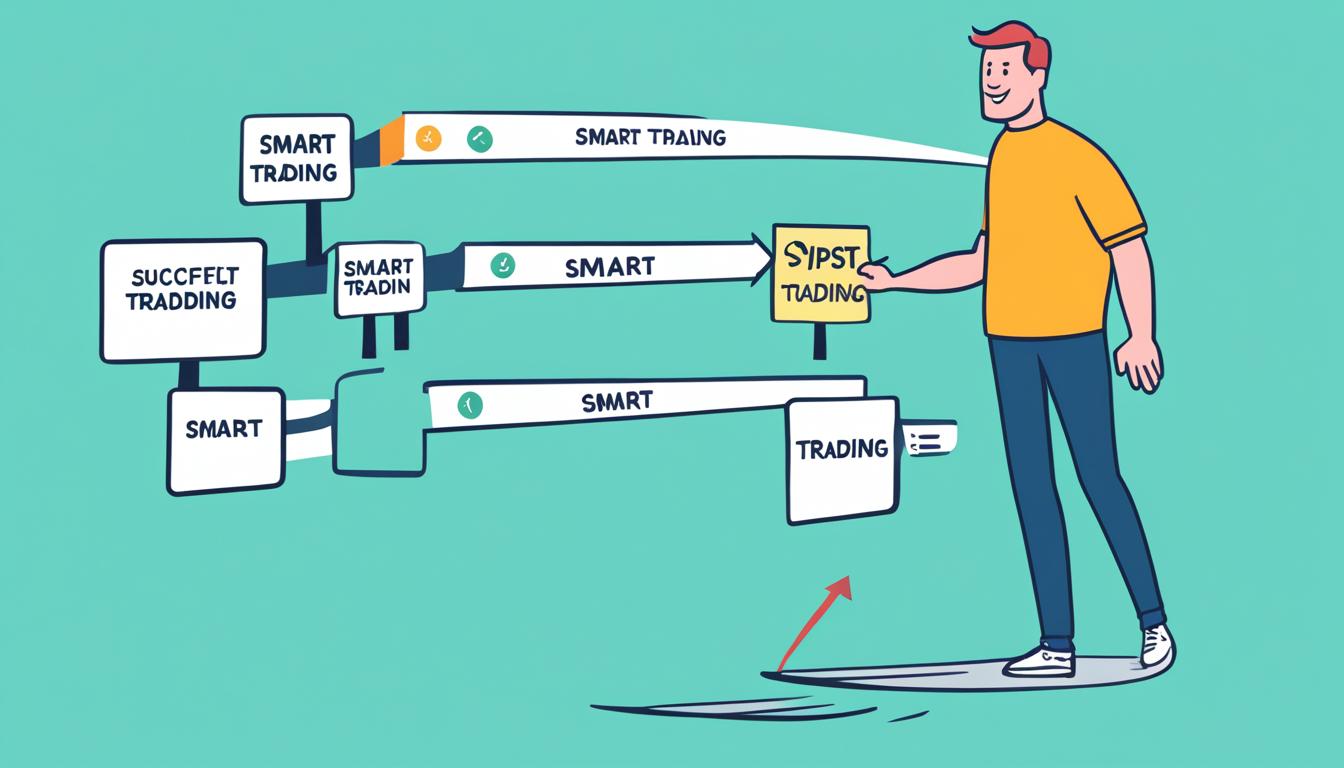Forex Trading Tips for Beginners: Start Smart
Did you know the forex market trades over $6 trillion every day? At first, these numbers might seem huge, but don’t worry. With the right guidance, even beginners can get into currency trading.
Forex trading used to be only for experts. Now, thanks to platforms like TPT Forex and TPT CopyTrading, anybody can start trading wisely. This guide will give you the basics so you can step confidently into your first trades.
Are you a complete beginner or do you want to improve your trading skills? Success in forex market means understanding it and making the right choices. Let’s start this journey together!
Key Takeaways
- The global forex market sees over $6 trillion in daily transactions.
- Forex trading is now accessible to everyone, not just financial experts.
- TPT Forex and TPT CopyTrading platforms can help beginners start smart.
- Understanding the basics of forex trading is crucial before making your first trade.
- Making informed decisions is key to success in currency trading for beginners.
Understanding the Forex Market
Jumping into forex trading is both fascinating and can lead to great returns. We’ll dig into the global currency market here. You’ll get a solid overview of how it works and who the main players are.
What is Forex Trading?
Forex trading is about trading currencies on the global market. It’s different from stock trading because it’s not in one central place. This means it happens all around the world, between big banks, companies, and people, at any time. To understand forex, you need to know about its big trade volume, 24/5 trading, and how world events affect currency prices.
Key Players in the Forex Market
The forex market has many faces, such as:
- Central Banks: These are banks like the Federal Reserve or the European Central Bank affecting currency values.
- Commercial Banks: They are the main forex traders, handling lots of trades daily.
- Hedge Funds: They are big money managers in forex, balancing risks or aiming for profits.
- Retail Traders: That’s ordinary people using forex to make money from currency changes.
Each player adds something special to the market, changing how things work.
Market Hours and Sessions
The forex market is open 24 hours a day, and here’s how that works:
| Trading Session | Region | Hours (GMT) |
|---|---|---|
| Tokyo | Asia | 00:00 – 09:00 |
| London | Europe | 08:00 – 17:00 |
| New York | North America | 13:00 – 22:00 |
| Sydney | Australia | 22:00 – 07:00 |
Each session shows more activity during region overlaps. They offer chances for traders to make deals based on new information from those areas.
Choosing a Forex Trading Platform
Choosing the right forex trading platform is key to success. There are many options in the market. Each one comes with unique features to make trading better.

Popular Forex Trading Platforms
There are several top forex trading platforms. They are known for being easy to use and offering advanced features. These are the best forex platforms for both new and experienced traders:
- MetaTrader 4 (MT4): It’s famous for its simple design and strong analysis tools.
- MetaTrader 5 (MT5): This upgrade to MT4 offers better charting and longer timeframes.
- cTrader: It has a sleek design and an advanced system for managing orders.
- NinjaTrader: It’s great for advanced charts and trading without manual input.
- TPT Forex: A good choice with top features, like easy strategy trading with TPT CopyTrading.
Features to Consider When Choosing a Platform
When picking a platform, look at certain important features. This ensures the platform meets your needs:
- Security: Choose reliable trading platforms that put your money and data safety first.
- User Experience: The platform should be easy to use, especially for new traders.
- Technical Analysis Tools: Good charting and indicators are vital for smart trading.
- Customer Support: Good support helps when you face problems or have questions.
- Forex Trading Technology: Look for advanced features like automatic trading, mobile access, and copy-trading for better efficiency.
When you think about these key features, you’ll be able to pick a platform that meets your trading goals. This will help you succeed in the forex market.
Forex Trading Basics: What Beginners Need to Know
Starting in forex means you must first understand the key words and ideas regularly used. We will go over the main terms in forex, explain major and minor currency pairs, and discuss leverage and margin. These elements are critical as they can either boost your gains or increase your losses.
Learning Forex Terminology
Forex trading has lots of special terms. But knowing them can help a lot in talking and deciding what to do. For instance, a ‘pip’ is the tiniest move in an exchange rate, and the ‘spread’ is the gap between what buyers and sellers want. Learning about pips, spreads, and lots is a great start for anyone new to forex.
Understanding Currency Pairs
In forex, you always trade one currency against another, showing their relationship. Major pairs pair the US dollar with another big world currency like the euro or the yen. Minor pairs skip the US dollar and include currencies from other strong countries. Choosing the right pairs is key to managing risk and fitting your trading style.
“You must understand and choose your currency pairs wisely to align with your trading goals,” say seasoned traders.
The Role of Leverage in Forex Trading
Leverage in forex allows you to control a big trade with just a little money. This can lead to bigger profits, but it also means bigger risks. Using leverage is like borrowing money to make your trades bigger. However, remember that margin is the money you must have in your account to keep a trade open. It’s easy to make big mistakes with leverage and margin if you’re not careful, so it’s important to use them wisely.
Understanding these basics will make you more ready to start forex trading. You’ll know about important terms, how currency pairs work, and the importance of leverage and margin. With this knowledge, you can make better decisions and control your risks well. It’s a solid beginning for a successful path in trading.
Developing Effective Forex Trading Strategies
Forex trading is more than understanding the market; it’s about using solid strategies. These strategies can improve your trading in the fast-paced forex market and help you meet your financial goals.

Introduction to Forex Trading Strategies
Strategic trading means developing and using strategies that fit your style, risk level, and goals. A clear plan makes your trading more methodical and less emotional. It also helps with detailed analysis, spotting trends, and finding good times to enter or exit the market.
Common Strategies for Beginners
Newcomers to forex trading should look at some common strategies:
- Trend Trading: It’s about seeing and following the market trends, aiming to ride the momentum with help from indicators.
- Day Trading: Here, you make trades that finish by the day’s end, cutting down on risks from holding positions overnight. Day traders use quick analysis to decide on their moves.
- Swing Trading: It’s designed for capturing short-term price changes during market trends. Traders here make fewer trades but focus on getting more profit each time.
Trading well means making strategies your own and changing them as you learn. Match your tactics to your goals and how much risk you’re willing to take. This keeps your trading smart and up to date with what’s happening in the market.
Forex Risk Management
When you dive into forex trading, knowing good forex risk management techniques is a must. It mixes strategy, discipline, and keeping your cool. These can keep your investments safe and make you better at trading.
Stop-loss orders are one key way to manage trading risks. They close a trade if the price hits a level you choose. This helps you keep your losses small, and it’s a tool every trader needs.
Finding the right position sizing is also crucial. It means figuring out how much money to use on each trade. This keeps a good balance between risk and possible reward. It stops one bad trade from hurting your whole investment too much.
It’s vital to consider the risk-reward ratio in your strategy as well. This ratio looks at the trade’s potential profit against the risk of loss. It helps you focus on trades that offer more reward than risk. Aim for a ratio of 1:2 or better. This means the reward is at least twice the risk.
Here’s a table summarizing the vital forex risk management techniques:
| Technique | Description |
|---|---|
| Stop-loss Orders | Automatically closes trade at a predetermined loss level |
| Position Sizing | Allocates capital to each trade based on risk tolerance |
| Risk-Reward Ratio | Ensures potential rewards outweigh risks |
Lastly, don’t forget the mental side of trading, like how losses hit us. Having a clear plan and sticking to it is key to staying calm. This, combined with using smart risk management, leads to a more successful trading path.
Mastering Forex Trading Psychology
In forex trading, doing well means more than having a smart strategy. It’s also about your mindset. You must learn to deal with feelings like fear, greed, and overconfidence. This is key to becoming a better trader.
“Control your emotions or they will control you.” This age-old wisdom resonates deeply in the practice of forex trading.
Handling your emotions is very important when you trade currencies. Acting on feelings during market changes often leads to bad choices. To stay level-headed, spend time thinking about your emotions. Also, practice being aware of your thoughts.
There are many ways to keep emotions in check:
- Set Clear Goals: Decide what you want to achieve with your trades and stay focused, no matter what.
- Practice Patience: Don’t rush to decide because the market seems to be moving fast.
- Implement a Trading Plan: Follow a solid plan in your trades to avoid emotional choices.

Improving how you deal with trading stress can make you better at forex trading. Tools like TPT Forex and TPT CopyTrading are useful. But, your self-control and mindset are what really makes you succeed. Focus on bettering these mental skills for smart and effective trading.
Getting Started With TPT Forex and TPT CopyTrading
Starting in forex, TPT Forex makes it easy to start trading. Knowing what TPT Forex is helps you make smart trading choices.
What is TPT Forex?
TPT Forex is well-known for its strong help and new tools. It gives you real-time info, great charts, and an economic calendar. It stands out by using automated trading systems to make trading smoother.
Benefits of TPT CopyTrading
TPT CopyTrading lets new traders copy what the pros do. It uses automated trading systems to make trades right away, which can boost your profits and cut down on risks. Here’s why TPT CopyTrading rocks:
- Simplicity: It’s easy to set up, perfect for beginners.
- Reduced Learning Curve: You can learn from the best without doing tons of research.
- Time Efficiency: Letting automatic systems trade for you saves time.
- Risk Management: You can set limits on your risk to feel more secure.
TPT Forex and TPT CopyTrading are great for those starting out. They help whether you’re learning about the market or want to use automated trading systems to trade better.
| Feature | TPT Forex | TPT CopyTrading |
|---|---|---|
| Platform | Offers lots of tools and information | Does trade copying automatically |
| Learning Curve | It’s a bit of a learning curve | Easy to get the hang of |
| User Accessibility | Easy to use for all | Easy to start using |
| Risk Management | You can adjust risk settings | Has safety measures in place |
Starting with TPT Forex and TPT CopyTrading makes entering forex smooth and smart. It’s a great way to start in the financial world.
Leveraging Forex Trading Signals
Forex trading signals are key for traders, whether you’re just starting or have lots of experience. They offer crucial insights, making your choices in the forex market more educated. In simple terms, these signals recommend when and at what price to trade a currency pair.
Signals can come from experts or automated systems. You can get them by signing up for trade recommendation services. These alerts are sent via email, SMS, or through your trading app.

- Technical Signals: These use technical analysis to suggest trade points. They look at price history, charts, and trends to recommend when to enter or exit a trade.
- Fundamental Signals: These focus on world events, news, and financial data. They aim to understand the public mood towards the market, using economic figures like job rates and GDP growth to predict trends.
It’s crucial to know where your signals come from and how they’re made. This helps you check their reliability and if they fit with your strategy. When choosing a service, consider its reputation and if it matches your goals, such as TPT Forex and TPT CopyTrading.
Integrating these signals into your trading plan is vital. Here’s a simple table showing how they can help:
| Signal Type | Key Features | Usage |
|---|---|---|
| Technical Signals | Chart Patterns, Statistical Trends, Indicators | Identify precise entry and exit points, minimize risks |
| Fundamental Signals | Economic News, Financial Reports, Market Sentiment | Understand broader market trends, make informed decisions |
Using forex trading signals can enhance your strategy. With a deep understanding of the market and these signals, you’ll trade better. This could give you an advantage in the ever-competitive forex market.
Forex Trading Tips for Beginners
Starting your forex trading journey? It’s key to have strong basic tips. First, try a demo account. It helps you trade without real money, getting used to platforms and tools.
Learn how global news affects currency values. Things like interest rate changes and job reports are big. They can change how the markets move a lot.
Make sure your goals are real and doable. Forex needs you to be patient and stick with it. If you expect too much, you might start making bad choices because you’re upset.
- Begin with a Demo Account: Develop your skills in a risk-free environment before trading live.
- Stay Informed: Keep up to date with global news and economic events that could affect currency markets.
- Set Realistic Goals: Aim for achievable trading objectives and remain patient throughout your journey.
Use what you can to learn more, like TPT Forex and TPT CopyTrading. These places are full of great tips from experts. Always keep learning in forex – it really pays off.
Continuing Your Forex Trading Education
To keep getting better at forex trading, it’s vital to keep learning. We’ll show you some great tools and tips for your education journey.
Recommended Resources for Learning
Investing in good learning materials can really help you understand the market better. Let’s look at some top choices for new traders:
- Books: “Currency Trading for Dummies” and “Day Trading and Swing Trading the Currency Market” are must-reads. They cover everything from beginner to advanced trading.
- Online Courses: Babypips and Investopedia offer in-depth forex courses for all skill levels.
- Webinars: Joining webinars by skilled traders gives you insights and real-life strategies.
Staying Updated with Market News
Staying on top of market news and global events helps you make better trading decisions. Here’s how you can stay informed:
- Financial News Outlets: Click into Bloomberg, CNBC, and Reuters for the latest market and economic news.
- Economic Calendars: Use a tool like Forex Factory’s Economic Calendar to watch important financial events. This can help you plan your trades better.
- Social Media: Follow top traders and experts on Twitter and LinkedIn. They often share quick news and valuable insights.
Integrating these resources into your daily learning can make you a better trader. Always remember, the forex trading world changes fast. So, learning all the time is key to succeeding.
Conclusion
Starting your forex trading journey needs more than just excitement. It needs a smart, informed, and disciplined approach. This article gives you key information on understanding forex, picking a platform, crafting great strategies, and dealing with the mental side of trading. By understanding these points, you’re set up for success in trading.
Remember, successful currency trading isn’t about quick wins. It’s about continuous learning and adapting. Using tools like TPT Forex and TPT CopyTrading can boost your knowledge and skills. This can make moving through the forex world easier. Whether you’re using trading signals or staying updated with market news, your moves should always be smart and well thought out.
Forex trading comes with great chances, but true success comes from ongoing learning, skillful risk control, and strong mental game. With the correct advice, tools, and effort, you can reach positive results in the forex world.
